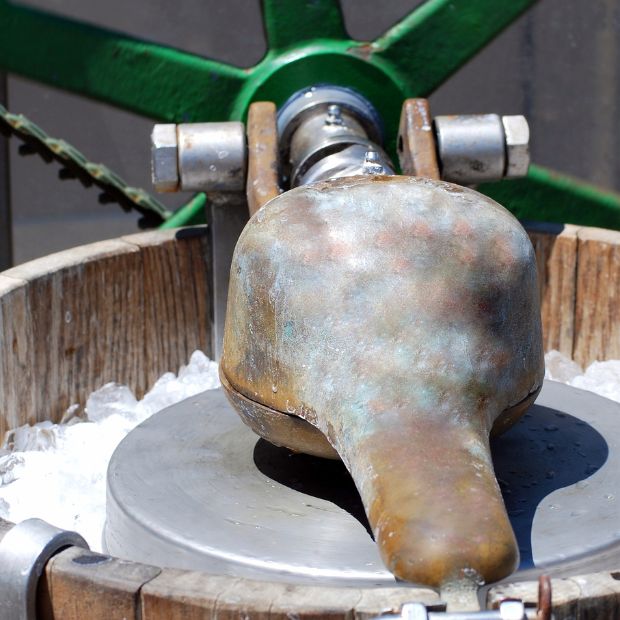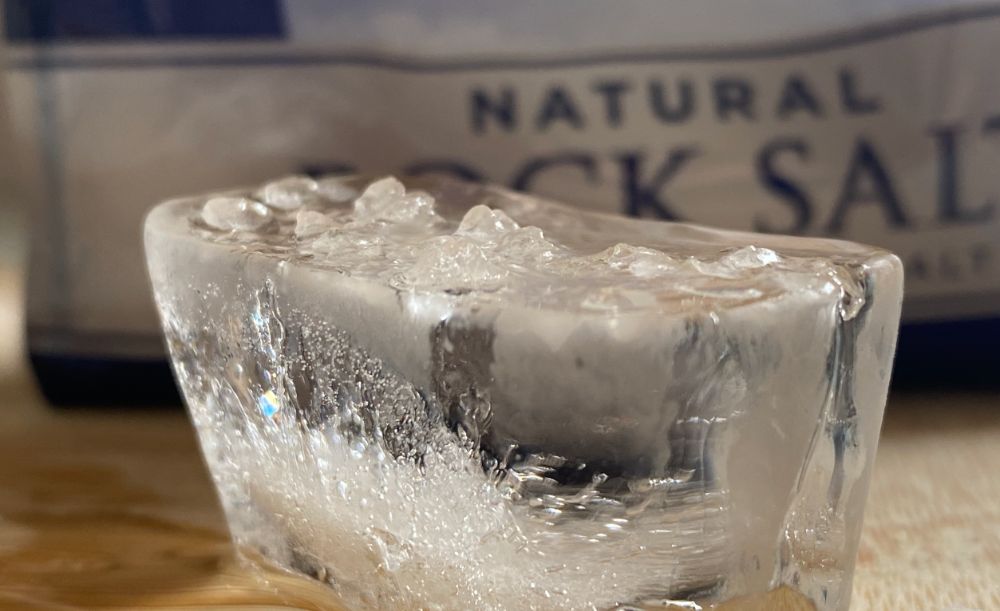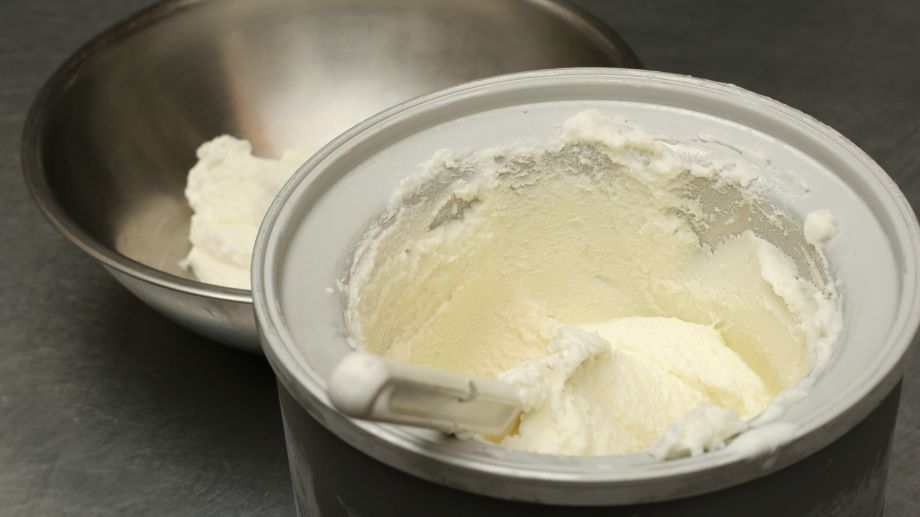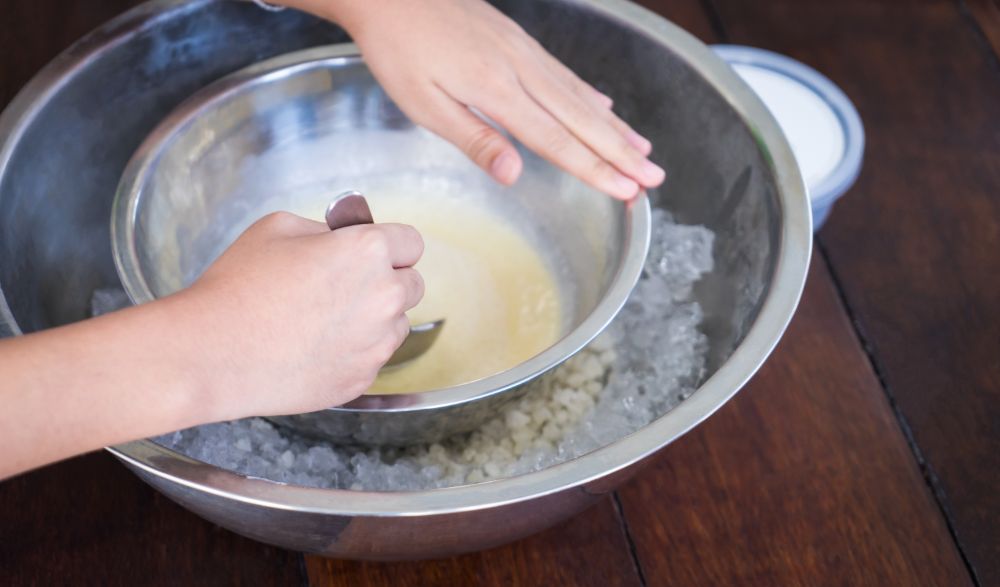When making home made ice cream you need to add salt to an outer bowl of ice water that freezes your ice cream as you churn it. But have you ever wondered what does the salt do to the ice when making ice cream?
Why do you need salt in the first place and is it even necessary? The answer is yes and here's why:
Adding salt to ice when making ice cream quickly lowers the temperature of the ice which is needed to make the ice cream solid. Without salt the outer ice doesn't get cold enough to freeze the ice cream and it will stay liquid.
Adding salt to the ice rapidly lower's it temperature and this in turn is used to lower the temperature of the ice cream below 32ºF (0ºC) allowing it to become solid and firm.
The quicker ice cream freezes as it is mixed the smaller the ice crystals inside the ice cream are, giving it that fluffy texture. The salt in the ice means the ice cream can freeze a lot faster leading to fluffier more delicious ice cream.
How Is Salt Used To Make Ice Cream?

Salt doesn't go in the ice cream itself, but rather goes in the ice on the outside of the ice cream bucket.
Generally if you're making homemade ice cream you have 2 buckets. An inner bucket with the ice cream and a churning or whisking device and an outer bucket with ice and salt.
If you were to just use salt alone in the outer bucket the ice itself wouldn't be cold enough to freeze the ice cream, or it would take significantly longer. This is because ice cream is designed to melt earlier than regular ice.
However, by adding salt to the ice you make the ice melt faster and through the magic of science this lowers the temperature of the ice below freezing point and down to as low as 20ºF (-7ºC) or even lower.
This extra cold ice is now cold enough to quickly freeze your ice cream as you churn it giving it
How Does This Happen?
Salt lowers the temperature of ice through 2 major processes.
1. Salt lowers the freezing point of ice making it melt…as the ice melts it's gets colder

Salt water starts to melt at colder temperature than regular ice. This is why they spray salt over the ice on the roads, it makes the ice melt earlier than it would otherwise.
So adding salt to ice makes the ice melt because it's freezing temperature is now lower than what it used to be.
Then…the process of the ice melting actually makes the ice COLDER!
Sounds crazy but it takes energy for water to turn from a solid into a liquid so as it melts it draws this energy in the form of heat from the surrounding ice cubes making them colder.
The more salt, the more ice that melts and the colder everything gets even as it melts.
2. As salt dissolves in water it gets colder
The process of dissolving salt in water also requires energy and it gets it from the water itself in the form of heat.
This means as the salt dissolves in the water/ice as it melts it also works to make the entire thing colder.
Can You Make Homemade Ice Cream Without Salt?
In the above video you can see an experiment where this lady tries to make 2 bags of ice cream.
One version she adds salt to the ice like recommended and the other she doesn't add the salt.
You can quickly and easily see that after 5-10 minutes the ice cream in the bag WITHOUT salt was not frozen and was still completely liquid.
The ice cream in the bag WITH salt was frozen after 5-10 minutes and was ready to eat.
No, you cannot make home made ice cream using just regular ice without salt. You need to add the salt to make the ice cold enough so the ice cream freezes. Without salt the ice cream will stay liquid.
Table Salt vs Rock Salt When Making Ice Cream

Some people say that rock salt works better than finer table salt in order to make ice cream. Some stating it's more pure and others stating is disperses the salt more evenly.
But a lot of people have had success with just regular table salt. So does it matter what kind of salt you use? Is rock salt actually better than table salt?
Looking at the experiment above you can find your answer:
When making home made ice cream you can use either rock salt or regular finer table salt. Both work just fine to lower the temperature of the ice and to freeze the ice cream. Neither seems to work better than the other.
Basically go ahead and use whatever salt you have or whichever salt is cheapest. You won't be eating the salt, it's only used to cool down the ice cream.
Why Is Salt Sometimes Added To Ice Cream

Some homemade ice cream recipes call for a pinch of salt or a small amount of salt.
Originally I thought this may be to lower the melting temperature of the ice cream but it turns out it has nothing to do with this and everything to do with flavor.
When adding salt to ice cream you only want to add a small amount. This small amount is going to enhance the flavors of your ice cream and really make them pop but in such small quantities it isn't going to noticeably affect the melting temperature of your ice cream.
It's very easy to overdo it with salt in ice cream so be very careful with how much you use.
You don't want you ice cream tasting salty you just want a tiny hint of the salt to improve the flavor.



